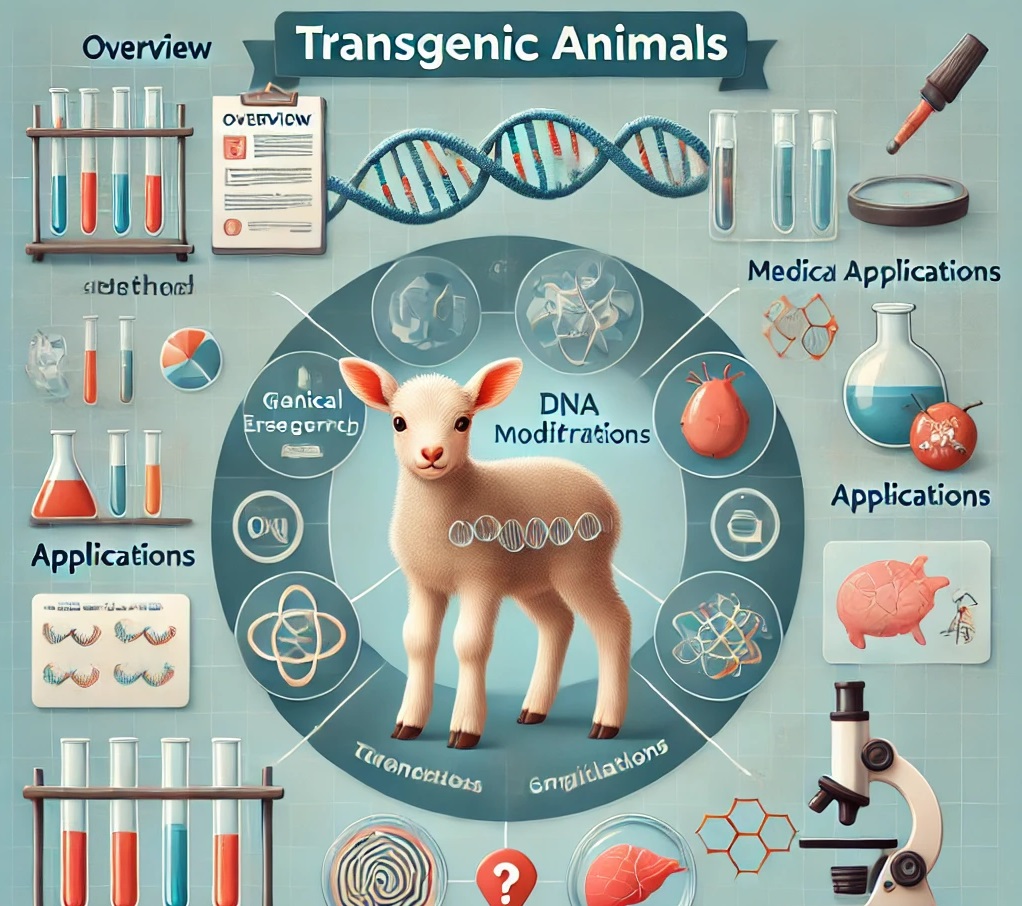
Transgenic Animals: Overview, Methods, Applications, and Ethical Considerations
Transgenic animals are genetically modified organisms (GMOs) that have been altered through genetic engineering to carry genes from other species. The primary goal of creating transgenic animals is to understand gene functions, model human diseases, produce pharmaceuticals, and enhance animal production traits. In this essay, we will explore the definition of transgenic animals, the methods used to create them, their applications in research, agriculture, and medicine, as well as the ethical issues surrounding their use.
1. What Are Transgenic Animals?
Transgenic animals are those that have been genetically engineered to contain foreign genes—genes that are not naturally found in their species. These animals are created through a variety of methods to integrate specific genes of interest into their genomes. The foreign genes can be derived from other animals, plants, or microorganisms and are introduced for various purposes, such as to study gene function, create models for human diseases, or produce valuable proteins.
The use of transgenic animals has become an essential part of biotechnology and genetic research. They serve as models to study complex biological systems, including human diseases such as cancer, Alzheimer’s, and cardiovascular diseases. They also play a role in agriculture, where transgenic animals are engineered to improve production efficiency and disease resistance.
2. Methods for Creating Transgenic Animals
The creation of transgenic animals requires advanced techniques to manipulate an animal’s genome. There are several methods used to produce transgenic animals, each with its own set of challenges and applications. The most commonly used methods include:
a) Microinjection Method
In this technique, foreign DNA is directly injected into the pronucleus of a fertilized egg, typically using a fine needle. The fertilized egg is then implanted into the uterus of a surrogate mother. This method is particularly useful in mice, the most common model organism in genetic studies.
While this method can be effective, not all fertilized eggs integrate the foreign DNA successfully, leading to low efficiency. Furthermore, the integration of the foreign gene may occur randomly, making it difficult to predict the exact location of integration within the genome.
b) Viral Vectors
Viruses can be modified to carry foreign genes and then infect animal cells, transferring the desired genetic material into the host’s DNA. This method is often used for creating transgenic animals that express therapeutic proteins or for gene therapy applications. Retroviruses and adenoviruses are among the most commonly used viral vectors.
One advantage of using viral vectors is that they can efficiently transfer large amounts of genetic material into host cells. However, the challenge lies in ensuring that the virus does not cause unintended side effects or insert the foreign gene into harmful locations within the host genome.
c) Embryonic Stem Cell Technology
This method involves the modification of embryonic stem cells in a laboratory setting. These cells are cultured and genetically altered, and then they are injected into early embryos of the host animal. When these embryos are implanted into surrogate mothers, the altered stem cells integrate into the developing animal’s tissues, producing a chimeric organism. If the stem cells contribute to the germline (cells that will produce offspring), the transgenic trait can be passed on to the next generation.
This method is particularly powerful for species that are difficult to manipulate by microinjection or viral vector methods, such as cattle and pigs. It allows for the creation of genetically modified animals that can carry transgenic traits in their offspring.
d) CRISPR-Cas9 Gene Editing
One of the most revolutionary developments in recent years has been the use of CRISPR-Cas9, a gene-editing tool that allows scientists to precisely modify the DNA of organisms, including animals. This system uses an RNA guide to target specific sections of the DNA, and the Cas9 enzyme then cuts the DNA, allowing for the insertion or removal of specific genes.
CRISPR technology has greatly enhanced the ability to create transgenic animals with high precision, making it possible to target specific genes and modify them in ways that were previously difficult or impossible. It has applications in gene therapy, disease modeling, and agriculture, with researchers using it to create transgenic animals with specific traits or to correct genetic defects.
3. Applications of Transgenic Animals
The creation of transgenic animals has led to significant advancements in various fields, including biomedical research, agriculture, and pharmaceuticals. The following sections explore some of the primary applications of transgenic animals.
a) Transgenic Animals in Biomedical Research
Transgenic animals are widely used to study gene function and disease mechanisms, creating more accurate models for human diseases. Some of the most important applications of transgenic animals in biomedical research include:
i) Disease Models
Transgenic animals, especially mice, are used to model human diseases by incorporating genes associated with specific diseases. For example, Alzheimer’s disease models are created by inserting human genes that are linked to the disease, such as the amyloid precursor protein (APP) gene. These animal models help researchers understand the progression of the disease and test potential treatments.
Similarly, cancer research benefits from transgenic animals that carry oncogenes or tumor suppressor genes that mimic human cancer. These models allow for the study of cancer growth and the testing of novel anti-cancer drugs.
ii) Drug Development and Testing
Transgenic animals play a key role in the development and testing of new drugs. Animals genetically modified to express certain human genes or disease phenotypes can be used to evaluate how potential drugs interact with human proteins. This helps researchers assess the safety and efficacy of new drugs before they are tested in humans.
For example, transgenic mice expressing human hepatitis C virus (HCV) genes can be used to test antiviral drugs. Similarly, animals with humanized immune systems can serve as models for testing immunotherapies for diseases like cancer and autoimmune disorders.
b) Transgenic Animals in Agriculture
In agriculture, transgenic animals are created to enhance food production and improve the quality of animal products. Some of the key applications include:
i) Improved Livestock
Transgenic livestock, such as cows, pigs, and sheep, have been engineered to increase production efficiency. For example, cows have been genetically modified to produce more milk, while pigs have been engineered to grow faster or be more resistant to diseases.
One notable example is the creation of “Enviropig”, a genetically modified pig that has been engineered to digest phosphorus more efficiently, reducing the environmental impact of waste from pig farms.
ii) Disease Resistance
Transgenic animals have been created with enhanced resistance to diseases that affect livestock. For example, genetically modified salmon have been developed to grow faster and be more resistant to disease. These fish are also more resilient to the environmental stresses often encountered in aquaculture.
Another example is the creation of genetically modified sheep that are resistant to scrapie, a prion disease that affects sheep and goats. These transgenic animals reduce the risk of disease spread, thus protecting the livestock industry.
c) Transgenic Animals in Pharmaceuticals
One of the most important applications of transgenic animals in medicine is the production of pharmaceutical proteins. Transgenic animals can be used as bioreactors, producing proteins that are used in drugs, vaccines, or diagnostic tests. These proteins are typically harvested from the animal’s milk, blood, or other bodily fluids.
i) Production of Therapeutic Proteins
Transgenic animals have been engineered to produce therapeutic proteins such as human antibodies, blood-clotting factors, and hormones. For example, mice and goats have been engineered to produce human monoclonal antibodies for the treatment of diseases such as cancer and rheumatoid arthritis.
The production of alpha-1-antitrypsin in transgenic sheep has been another important achievement. This protein, used in the treatment of cystic fibrosis and chronic obstructive pulmonary disease (COPD), is produced in the milk of genetically modified sheep.
4. Ethical and Environmental Concerns
Despite the tremendous benefits of transgenic animals, their creation and use have raised ethical and environmental concerns. Some of the key issues include:
a) Animal Welfare
One of the most significant ethical concerns is the welfare of transgenic animals. The genetic modification process itself can cause unintended effects on the animals, leading to health problems, deformities, or early death. Additionally, many transgenic animals experience abnormal behavior or physical stress as a result of the genetic alterations. Ethical questions arise about whether it is acceptable to subject animals to genetic modification for research or commercial purposes.
b) Environmental Impact
The release of genetically modified animals into the environment could have unintended ecological consequences. For example, transgenic animals that are designed for faster growth or disease resistance could potentially outcompete wild populations, leading to a loss of biodiversity. Additionally, there are concerns about the accidental release of transgenic organisms into the wild, which could lead to the spread of genetically modified traits in natural populations.
c) Genetic Integrity and Human Rights
Some critics argue that creating animals with foreign genes could lead to the manipulation of genetic traits in ways that are unnatural and unethical. There are also concerns about the humanization of animals, especially in research where animals are genetically modified to carry human genes or exhibit human-like traits. This raises questions about the moral status of such animals and their treatment.
d) Regulation and Oversight
The regulation of transgenic animals varies by country, but in many regions, there is a lack of clear and consistent guidelines. This has led to concerns about the safety of transgenic animals, especially in the food and pharmaceutical industries. Regulatory bodies, such as the FDA in the United States and the **European Medicines
10 Questions with detailed Answers on Transgenic Animals, covering their creation, applications, ethical considerations, and more.
1. What are transgenic animals, and how are they created?
Answer:
Transgenic animals are animals that have had foreign genes introduced into their DNA to express specific traits or proteins that are not naturally present in their species. They are created using genetic engineering techniques such as microinjection, where the desired gene is directly injected into a fertilized egg, viral vector methods, or more recent methods like CRISPR-Cas9 gene editing. These techniques enable scientists to study specific gene functions, model human diseases, and produce valuable proteins for medical use.
2. What is the primary purpose of using transgenic animals in research?
Answer:
The primary purpose of using transgenic animals in research is to understand gene functions and disease mechanisms, create models for human diseases, and develop new medical treatments. For example, mice engineered with human genes linked to Alzheimer’s disease or cancer allow researchers to study the disease’s progression and test new drugs. Transgenic animals help bridge the gap between laboratory studies and human clinical applications by providing more accurate biological models.
3. How are transgenic animals used in agriculture?
Answer:
In agriculture, transgenic animals are used to improve livestock productivity, enhance disease resistance, and reduce environmental impact. For instance, genetically modified cows can produce more milk, pigs are engineered to grow faster or digest phosphorus more efficiently (as seen in the “Enviropig”), and salmon are modified to grow rapidly and resist diseases. These modifications aim to increase food production efficiency, improve animal health, and reduce the ecological footprint of animal farming.
4. What are some examples of therapeutic proteins produced by transgenic animals?
Answer:
Transgenic animals have been engineered to produce valuable therapeutic proteins in their milk or blood. Examples include human insulin, alpha-1 antitrypsin (for treating lung diseases), and antibodies used in cancer treatment. For instance, transgenic goats have been modified to produce human blood-clotting factors in their milk, which is essential for patients with hemophilia. These animals act as bioreactors, providing a cost-effective and efficient way to produce large quantities of drugs.
5. How does CRISPR-Cas9 improve the creation of transgenic animals?
Answer:
CRISPR-Cas9 is a gene-editing tool that allows for precise, targeted modifications in the DNA of organisms, including animals. It works by cutting DNA at a specific location, allowing for the insertion, deletion, or alteration of genes. CRISPR-Cas9 has significantly improved the efficiency and accuracy of creating transgenic animals by enabling scientists to precisely target genes of interest. This precision reduces unintended effects and improves the likelihood of desired traits being expressed, making it highly useful for both research and therapeutic applications.
6. What are the ethical concerns surrounding the use of transgenic animals?
Answer:
Ethical concerns include animal welfare, environmental impact, and genetic integrity. The process of genetic modification can lead to unintended health issues or physical stress in transgenic animals, raising concerns about animal suffering. There is also the risk that genetically modified animals could escape into the wild and disrupt natural ecosystems. Some people worry about the implications of modifying animals to carry human genes, which may blur the boundaries between species and lead to moral dilemmas about the animals’ treatment and status.
7. How are transgenic animals regulated, and why is regulation important?
Answer:
The regulation of transgenic animals varies across countries and typically involves assessing their environmental impact, animal welfare, and potential risks to human health. Regulatory bodies like the FDA in the United States and the European Medicines Agency in Europe establish guidelines for the safe use and development of transgenic animals, particularly in the food and pharmaceutical sectors. Regulation is crucial to ensure that these animals are ethically and safely integrated into research and industry, protecting both the animals and the public.
8. What role do transgenic animals play in personalized medicine?
Answer:
Transgenic animals play a critical role in personalized medicine by helping to develop treatments tailored to an individual’s genetic makeup. By creating transgenic models with human-specific genes or disease traits, researchers can study how genetic variations influence disease and drug response. This knowledge helps develop more effective and personalized treatments for conditions such as cancer, cardiovascular diseases, and rare genetic disorders, facilitating the development of drugs that are targeted to individual patient profiles.
9. How are transgenic animals used to model human diseases?
Answer:
Transgenic animals are often engineered to carry human genes associated with specific diseases, making them valuable models for studying those conditions. For example, mice modified with genes linked to Alzheimer’s disease, Parkinson’s disease, or cancer allow scientists to observe the development of these diseases and evaluate potential treatments. These animal models mimic human disease processes more accurately than non-transgenic animals, providing insights into disease progression and treatment efficacy that are crucial for drug development.
10. What are the environmental concerns associated with transgenic animals?
Answer:
Environmental concerns include the risk of genetically modified animals escaping and breeding with wild populations, potentially leading to ecological imbalances or the spread of modified genes in the wild. For example, transgenic fish that grow faster than wild fish could outcompete them for resources, affecting biodiversity. Additionally, there are concerns about gene flow from transgenic livestock to wild relatives, which could disrupt local ecosystems and harm native species. Strict containment measures and environmental assessments are essential to mitigate these risks.






